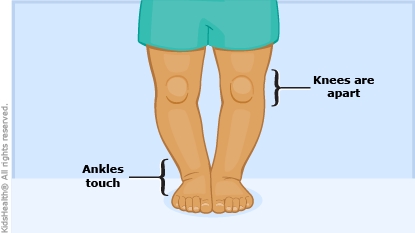Bow Legs (Genu Varum): How to Care for Your Child
Bow legs, or genu varum (GEE-noo VAY-rum), is a condition in which the legs curve outward at the knees while the feet and ankles touch. Infants and toddlers often have bow legs. Sometimes older kids do too. It is rarely serious and usually goes away without treatment.



-
Your child has pain, weakness, limping, or trouble running.
-
The bow legs get worse after age 2.
-
One leg is more bowed than the other leg.
-
Your child has bow legs that don't get better by the time the health care provider told you they should.

What causes bow legs? Most babies are born with bow legs because when they were growing in the womb, some of the bones had to rotate (twist) slightly to fit into the small space. As a child starts walking, the bowing might increase slightly and then get better. Children who start walking at a younger age have more noticeable bowing.
What can be done for bow legs? Bow legs don't usually need treatment since the legs normally straighten out by age 2. Health care providers will keep an eye on kids with bow legs and check to make sure the condition gets better as they grow. Some kids need to see an orthopedic doctor (bone specialist) if the legs are not straightening on their own. In rare cases, kids with bow legs may need dietary supplements, leg braces, or surgery to straighten the legs.
Can bow legs be a sign of something more serious? Yes, sometimes bow legs are related to other medical conditions. For example:
-
Rickets is a bone growth problem caused by lack of vitamin D or calcium in the body. This is much less common today than in the past. It can be treated with vitamin D and calcium supplements.
-
Blount disease is a growth disorder that affects the bones of the legs. The cause is unknown, but it may be treated with bracing or surgery.
-
Other conditions, such as injury or an infection, may affect bone growth around the knee.